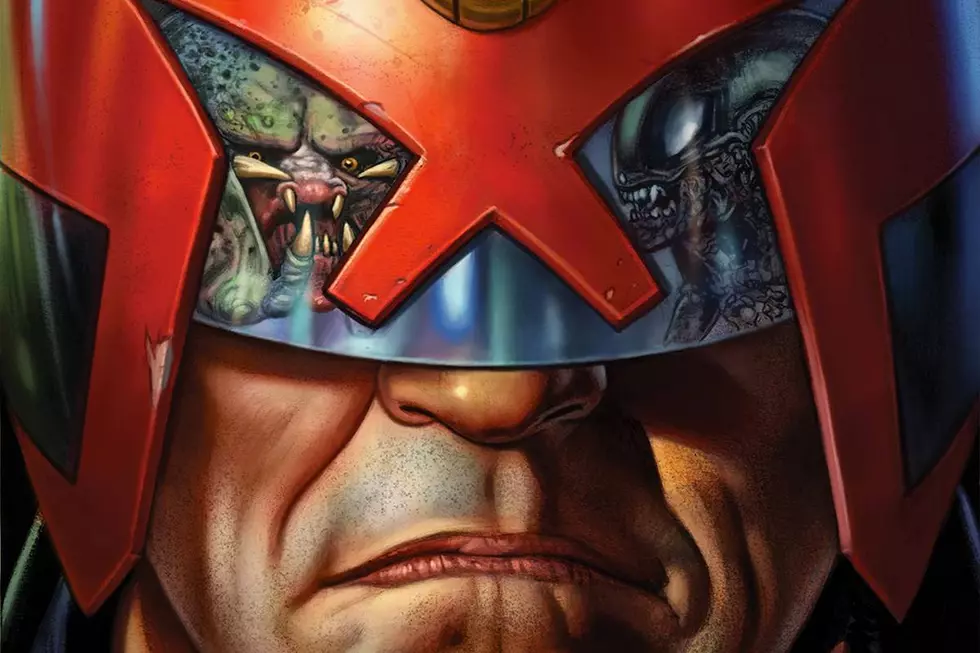![‘Five Ghosts: The Haunting of Fabian Gray’ #1: Pure Pulp [Review]](http://townsquare.media/site/622/files/2013/03/five-ghosts-1.jpg?w=980&q=75)
‘Five Ghosts: The Haunting of Fabian Gray’ #1: Pure Pulp [Review]

Some of the best comics come from the simplest ideas. Those ideas that seem to straddle the line between inventive and obvious so delicately, you want to hit yourself for not thinking of it first. Image's Five Ghosts: The Haunting of Fabian Gray by Frank Barbiere and Chris Mooneyham is built around such an idea. The concept is lip-smackingly good: a dashing adventurer is possessed by the spirits of five literary ghosts: Merlin, Robin Hood, Sherlock Holmes, Miyamoto Musashi, and Dracula. You had me at hello, right? Ridiculously simple but still pretty awesome, it's so dumb it's brilliant. And that's an actual compliment, not a backhanded one. But even the greatest idea means nothing if the execution is faulty. So how does Five Ghosts do with a great idea?
Pulp adventure is a genre that has been largely overlooked for the better part of five decades in American comics -- ever since superheroes took over, the genre has slowly dwindled into a niche market with only a few strong examples popping up a couple of times a year. Wishful thinkers like myself keep hoping for a full resurgence of pulp-style stories, but know deep down in our painfully hollow cores that we just have to get our kicks where we can and enjoy the handful of sterling books that show up from time to time.
They're still out there. Right now, we're drooling over ComicsAlliance favorites like IDW's new Rocketeer comics and Francesco Francavilla's Black Beetle. Even though the genre is mostly dead (or slightly alive), there have been some good pulp comics over the last few years. Maybe not enough to fill that desolate hole where joy once lived, but enough books of high quality to at least throw some sand in there or something. Five Ghosts is probably the only one that really seems like it actually could have been created in the heyday of the genre.
 Five Ghosts: The Haunting of Fabian Gray is a throwback comic that reaches back long before the days of post-modernism and irony, forgoes deconstruction, and genuinely behaves like a pulp adventure comic magazine. And it never feels like it's just doing an impression, or that its creators were experimenting in styles. From the concept to the cover, it all seems like it could hop into a wayback machine and blend into the newsstands of other eras -- eras when comics were actually on newsstands.
Five Ghosts: The Haunting of Fabian Gray is a throwback comic that reaches back long before the days of post-modernism and irony, forgoes deconstruction, and genuinely behaves like a pulp adventure comic magazine. And it never feels like it's just doing an impression, or that its creators were experimenting in styles. From the concept to the cover, it all seems like it could hop into a wayback machine and blend into the newsstands of other eras -- eras when comics were actually on newsstands.
The plot seems like it was ripped out of some anonymous comic book writer's head in 1938. After coming into contact with a magical artifact called "the dreamstone," treasure hunter Fabian Gray (squee!) becomes the vessel for the spirits of the five "literary ghosts": The Wizard, The Archer, The Detective, The Samurai, and The Vampire. Against the backdrop of 1930s Europe, he uses their abilities to hunt for mystical artifacts, desperately trying to find a cure for his cursed twin sister and rid himself of the spirits that possess him.
It has everything a classic pulp adventure needs -- a concept that's simultaneously amazing and ridiculous (just what is a "literary ghost?" Wasn't Musashi a real guy?), mystical shenanigans, bi-planes, Nazis, a studious sidekick, African spider tribes, ghostly images of heads floating in empty space, a beautiful, tough-as-nails love interest, and an entire cast that smokes two packs of Lucky Strikes a day. The only thing that would make it feel more authentic is Fredric Wertham's testimony.
Beyond the characters and the plot, the whole execution is decidedly pulpy. The writing adopts several characteristics of older stories without ever seeming like a straight pastiche. The captioning and dialogue reads like an old comic -- it's more polished, more artful, and less cluttered than most adventure comics of the Golden Age, but it has the same feel, like it's borrowing the rhythms and tenor of comics from decades ago. Dialogue that would seem awful anywhere else, i.e. "Ha ha ha...is that the best you can do?" just seems to add an authentic feel of un-sophistication.
It's even paced almost like a serial, with several short episodes of four or five pages that each end with a full splash page of an explosion, or a villain laughing maniacally. It's a little herky-jerky at first, but once you get what Barbiere is going for, it's fun, and it works.
But the star of Five Ghosts:The Haunting of Fabian Gray is artist Chris Mooneyham. With a style that could easily be described as classic comics illustration, I genuinely wouldn't be surprised if he's actually from the early sixties and just got stuck in a time vortex that brought him to 2013. Frank Miller is the most obvious influence, and probably the most modern -- everything else looks like Neal Adams, Gil Kane, Joe Kubert, Alex Toth, and a gaggle of EC guys. With a thin, malleable line, good sense of layouts and action, his style seems to ignore everything that's happened in comics art since 1990 -- and yes, that's a good thing. Mooneyham is an early frontrunner for best debut. Does that award category even exist? Let's make one.
Overall, Five Ghosts: The Haunting of Fabian Gray is an exciting new series, with creators who not only clearly love classic pulp adventure, but are able to recreate its novelty and excitement in a genuine way. Fast-paced, exciting, exotic, and comfortingly familiar, it's worth picking up, and available online and in finer comics shops.






More From ComicsAlliance









